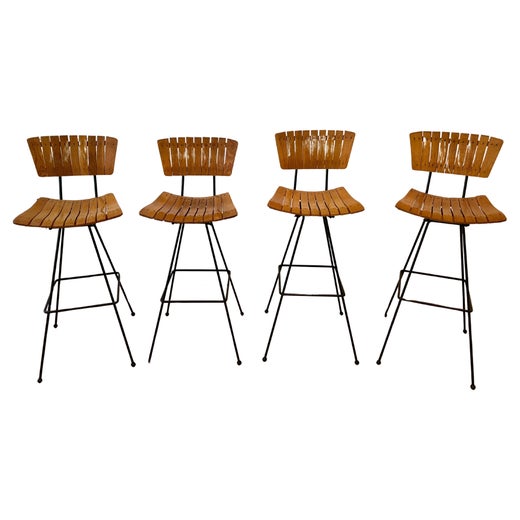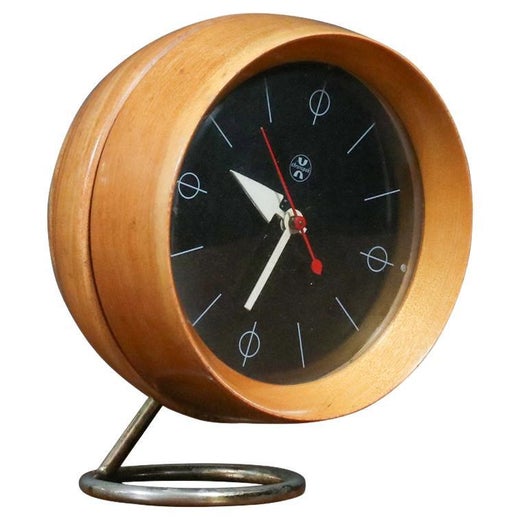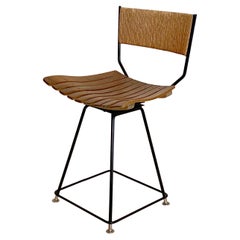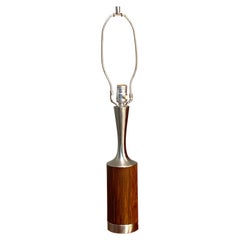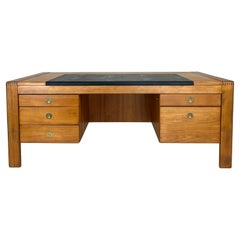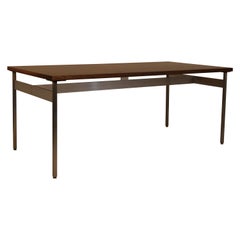Rosewood Desk Clock by Howard Miller
About the Item
- Creator:
- Dimensions:Height: 5.5 in (13.97 cm)Width: 4 in (10.16 cm)Depth: 3.5 in (8.89 cm)
- Style:Mid-Century Modern (Of the Period)
- Materials and Techniques:
- Place of Origin:
- Period:
- Date of Manufacture:circa 1960
- Condition:Excellent.
- Seller Location:South Charleston, WV
- Reference Number:Seller: HM clock1stDibs: LU1616213423271
Arthur Umanoff
Though much of Arthur Umanoff's furniture is marked by a no-frills simplicity common in American mid-century modern design, his work is anything but one-note. Over the course of a prolific career, Umanoff designed everything from case pieces to candleholders to magazine racks to dining chairs in iron, leather, walnut, wicker and more. With furnishings for a broad range of manufacturers throughout the ’50s, ’60s, ’70s and early ’80s, Umanoff continued a thread of sculptural elegance and textural sensitivity through his designs.
After graduating from Pratt Institute in the early 1950s, Umanoff experimented mostly with wood furniture before landing a job at Post Modern Ltd, a New York manufacturer of wrought-iron furniture. There he produced furnishings that married wrought iron with wood and plastic, creating functional pieces free of utilitarian bulkiness.
Umanoff continued his experimentation with mixed materials through a partnership with Shaver Howard, for whom he designed wine racks in combinations of iron, leather and wicker.
When Shaver Howard bought Boyeur Scott, Umanoff conceived several furniture designs for the brand, including the 1964 Granada collection, whose curlicue iron bases, visible through glass tops, stand out as some of his most ornate and decorative work. Indeed, much of Umanoff’s oeuvre is far more simplistic, like iron-and-pine armchairs for The Elton Co. or low-backed, slatted-seat barstools with slender iron legs for Raymor.
Umanoff was fluent, too, in the more sumptuous modernism of the era: In the mid-1960s, he designed the 2405 and 4449 armchairs for Madison Furniture Industries. Popular in offices, the walnut-framed, leather-upholstered seats, which could have been mistaken for the seductive Scandinavian modern seating of the era, were reportedly the jumping-off point for Captain Kirk’s iconic seat on Star Trek.
Even as he is among the mid-century modern designers you may not know, with work across such a range of styles and manufacturers (most no longer in business), Umanoff, who died in 1985, leaves a legacy that is fascinatingly diverse and at times enticingly elusive, making his work intriguing objects for collectors.
Find vintage Arthur Umanoff bar stools, tables, benches and other furniture today on 1stDibs.
George Nelson
Architect, designer, and writer George Nelson was a central figure in the mid-century American modernist design movement; and his thoughts influenced not only the furniture we live with, but also how we live.
Nelson came to design via journalism and literature. Upon receiving his bachelor’s degree in architecture from Yale in 1931, he won the Prix de Rome fellowship, and spent his time in Europe writing magazine articles that helped bring stateside recognition to Ludwig Mies van der Rohe, Gio Ponti, Le Corbusier and other canonical modernist architects.
In the 1940s, Nelson wrote texts that suggested such now-commonplace ideas as open-plan houses, storage walls and family rooms. D.J. De Pree, the owner of the furniture maker Herman Miller, was so impressed by Nelson that in 1944 — following the sudden death of Gilbert Rohde, who had introduced the firm to modern design in the 1930s — he invited Nelson to join the company as its design director. There Nelson’s curatorial design talents came to the fore.
To Herman Miller he brought such eminent creators as Charles and Ray Eames, Isamu Noguchi, and the textile and furniture designer Alexander Girard. Thanks to a clever contract, at the same time as he directed Herman Miller he formed a New York design company, George Nelson & Associates, that sold furniture designs to the Michigan firm. Nelson's studio also sold designs for clocks to the Howard Miller Clock Company, a manufacturer that was initially part of Herman Miller before it became an offshoot that was helmed by Howard Miller, D.J. De Pree's brother-in-law.
Nelson’s New York team of designers (who were rarely individually credited) would create such iconic pieces as the Marshmallow sofa, the Coconut chair, the Ball clock, the Bubble lamp series and the many cabinets and beds that comprise the sleek Thin-Edge line.
For dedicated collectors, as well as for interior designers who look beyond “the look,” there is a “cool factor” inherent to vintage pieces from George Nelson and others. Nelson was in on it from the start, and it’s valuable to have a piece that was there with him.
But still, as is evident from the offerings from dealers on 1stDibs, in any of the designs, in any iteration whose manufacture Nelson oversaw and encouraged, there are shining elements of lightness, elegance, sophistication — and a little bit of swagger. George Nelson felt confident in his ideas about design and didn’t mind letting the world know.
You May Also Like
Vintage 1960s American Mid-Century Modern Table Clocks and Desk Clocks
Aluminum
Vintage 1960s American Mid-Century Modern Table Clocks and Desk Clocks
Chrome
Vintage 1950s American Mid-Century Modern Table Clocks and Desk Clocks
Metal, Chrome
Vintage 1970s American Mid-Century Modern Grandfather Clocks and Longcas...
Metal
Vintage 1950s American Mid-Century Modern Table Clocks and Desk Clocks
Metal, Brass
Vintage 1950s American Mid-Century Modern Table Clocks and Desk Clocks
Metal, Brass
Mid-20th Century American Mid-Century Modern Wall Clocks
Metal
Mid-20th Century Mid-Century Modern Wall Clocks
Rattan, Wood
Vintage 1970s North American Mid-Century Modern Wall Clocks
Aluminum, Brass
Vintage 1970s American Mid-Century Modern Wall Clocks
Brass
More From This Seller
View AllVintage 1960s American Mid-Century Modern Office Chairs and Desk Chairs
Steel
Vintage 1960s American Mid-Century Modern Table Lamps
Chrome
Vintage 1970s Singaporean Mid-Century Modern Desks
Teak
Vintage 1970s American Mid-Century Modern Desks
Aluminum, Steel
2010s American Mid-Century Modern Dining Room Tables
Steel
Vintage 1980s American Mid-Century Modern Conference Tables
Aluminum
Recently Viewed
View AllRead More
A Guide to Herman Miller’s Most Iconic Furniture
The prolific manufacturer has partnered with many of the world’s top designers since opening its doors in 1923. Here are some of the company’s greatest hits, which helped transform the American home and office.
Kule and Forsyth Give Iconic Furniture a Bold Makeover with Stripes
Maggie and Anne Genovese, of Forsyth, teamed up with fashion designer Nikki Kule to reimagine some classic pieces.
